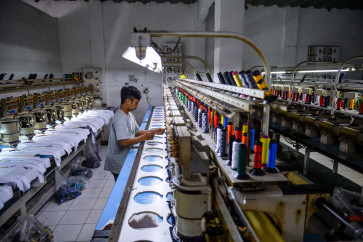Popular Reads
Top Results
Can't find what you're looking for?
View all search resultsPopular Reads
Top Results
Can't find what you're looking for?
View all search resultsBig data: An alternative to present the truth
The lack of attention researchers and academics have given to big data compared to the enthusiasm among businesses, shows that big data has not been utilized to develop science.
Change text size
Gift Premium Articles
to Anyone
F
ewer people will rely on surveys as primary data sources within the next five to ten years. Surveys are not only expensive but also time consuming; this is where big data comes in.
Big data is not only “big” because of its massive volume but also for its capability to produce real-time updates and complex sources, types and categories. In short, big data presents a broader and more complex depiction of reality, which is difficult to reach through conventional surveys.
So far, most researchers, analysts and academics rely on static data derived from a research field’s primary data available at the Central Bureau of Statistics (BPS), research institutes, universities and international institutions, such as United Nations Development Program (UNDP) and World Bank.
Big data not only accommodates static data but also provides dynamic data, which changes rapidly. Dynamic data comes from online portals, including social media, such as Twitter, Facebook and Instagram.
Dynamic data is useful for urgent and short-term purposes. Through dynamic data, we can quickly identify and respond to critical events, such as crop failure, fires, infectious diseases or violence against women and children. We can even identify the symptoms of radicalism or predict political preferences.
Big data machinery help us know the number of occurrences in a certain period of time, the spread of region, the cause category, and even the relationship between the group and the actors involved. In other words, big data provides information that is not available from traditional research institution and conventional methods.
Building the truth
Big data is a new technique for presenting certain truths; proliferation of information technology plays a vital role in constructing society’s knowledge.
Big data requires availability of information technology to process millions and even billions of data, whether structured or not structured, fragmented or intact.
A large volume of data cannot be processed and analyzed by conventional analytical computational techniques. With a big data analytical engine, the original raw unstructured data unveils information through patterns, relationships and coherences.
As of now, only a researchers and academics in the country are interested in Big Data.
At the international conference, Big Data for Life, in, none of the speakers were researchers and academics. Instead people reporting on big data came from business and media industries.
(Read also: Big data driven strategies to solve global problems)
The lack of attention researchers and academics have given to big data compared to the enthusiasm among businesses, shows that big data has not been utilized to develop science.
Chris Anderson, former Chief Editor of Wired Magazine, criticized academics by saying big data is the approach to produce knowledge in a new era that marked "the end of theory". The conventional scientific method is outdated. We do not need to bother building a hypothesis on the basis of a theory. Big data algorithms facilitate a variety of complicated data analysis.
Constructing the truth is the duty of scientists, academics and researchers. The responsibility of big data is in their hands.
For scientists, researchers and academics, big data opens a door to enrich the variety of data, to strengthen the analysis, which further develops opportunities for more elaborate interdisciplinary research.
However, big data absorbs dynamic data from open sources, such as news sites and social media, which presents fragmented data. Big data leaves a hole in scientific rules, for example, reliability and validity. This is a challenge for researchers and academics, to examine and reconstruct big data so that it becomes more reliable.
Structuring fragmented large volumes of data requires scientific procedures.
Only by exploring big data, researchers and academics can draw from the benefits.
***
Wildan Pramudya is a senior researcher and head of the research division at Indonesia Indicator (i2) Jakarta. He is deeply concerned with social-political issues, philosophy and big data. He can be reached on Facebook (Wildan Pramudya) and through his blog: https://pramudyarifin.wordpress.com/
---------------
We are looking for information, opinions, and in-depth analysis from experts or scholars in a variety of fields. We choose articles based on facts or opinions about general news, as well as quality analysis and commentary about Indonesia or international events. Send your piece to community@jakpost.com. For more information click here.










